by Gaby González and Marcela Armas
“It is obvious that the chemical analysis of a compost with regard to its nitrogen, phosphate and potash content (NPK) gives only limited and incomplete information as to its biological value. Nor does it really tell how good a compost is… Humus is not a definite chemical substance but a state of matter, an integration of mineral with organic matter.”
- Ehrenfried E. Pfeiffer, Chromatography Applied to Quality Testing. The Art and Science of Composting
“Iridology is a relatively new science still; a lot of changes to be made yet, but there is something basic that stands behind them related to physiological and pathological changes of the body. When we start seeing the correlation between the clinical history of the patient with the findings in the iris, the true value of this form of analysis and diagnosis is revealed.”
- Dr. Bernard Jensen, Science and Practice of Iridology
“The true art of healing is the one that teaches the patient to change his life habits therefore, according to natural laws, instead of having to rebuild his body may avoid disease before it even starts”.
- Dr. Bernard Jensen
“Approach a fact as a kid would do. Be willing to renounce all preconceived notions; humbly carry on wherever and whenever, to any abyss into which life carries you, or you’ll never learn anything.”
- Thomas Huxley
Mirrors of the Holobiont seeks to establish a relationship and dialogue between iridology and soil chromatography, two systematic study methods used for the diagnosis of the state of health of two diverse, but interrelated living bodies: the human body and the Earth.
Both methods share two qualities. They have a graphic or visible character, making them legible, subject to methodical analysis and interpretation. They also possess a high degree of interconnectivity with the organism to which they belong. (Ariel Guzik 2000).
The project is an investigation that transverses diverse areas of human knowledge: ancestral knowledge and sciences, for instance, biology, microbiology, botany, traditional herbal medicine, peasant agriculture, philosophy between others. We are looking for their points of convergence, taking both an artistic and a critical approach.
Mirrors of the Holobiont suggest the relationships (whether human, animal or vegetable) that come together to create the overarching oneness of the creation, which emerges through their connection. Thus, "holos" from the latin, meaning all or whole, refers to a loose grouping of relationships or bionts whose complex interactions create the larger composit or holobiont.
The concept originated with the German biologist Adolf Meyer-Abich in 1943 and was further elaborated on by Dr. Lynn Margulis in 1991. Holobionts are composed of whatever contributes to the whole they represent. Thus, in our case, we intend to work with chromatography and iridology, the techniques through which we'll study the holobiont collaboratively.
To explain further, we will be using Iridology as a diagnostic methodology through which we can determine the quality of health by analyzing the features of the human iris. Historically, this approach has been used to diagnose ailments in the human body. Iridology brings in the dimension of the inheritance or ancestry of each individual also, along with the particular life experiences that impact the (w)holistic state of the physical body.
Chromatography enlarges the picture. It is a technique that uses the dilution of a substance or matter, applied to previously sensitized filter paper with silver nitrate. This provides color patterns that can reveal information about the original material. Chromatography is a diagnostic tool that can help interpret patterns as signs of health of tested material according to its vital relationships. In this case, for the sake of this research, only soil chroma tests will be diagnosed and studied. As iriodology tests the health of the body, chromatography tests the health of land.
From an artistic perspective, a chroma is technically a revelation. It is the frame of film or a snapshot of a moment in the life of the soil. Similarly, the iris is a highly sensitive organ, which, according to Bernard Jensen, is a "receiving station" for messages from all parts of the human body. It also reflects to the outside what is known within.
In bringing these two tools together, this research looks for any intrinsic correlation between the health of the soil in an ecosystem and the health of the individual living on and perhaps farming that land. Another aspect is whether differences can be detected among the irises of that farmer on the land, a person not connected to land in any form, and even someone who lives in urban areas eating fast food. We are interested in determining whether chromas can decipher the patterns associated with foods and other substances that impact human urban environments and, ultimately, perhaps, the human who ingests them.
We intend to use alternative scientific methodologies–those not recognized by the medical or agricultural science fields–to identify how environmental health directly impacts our health and vice versa. To do this, we'll compare a chroma test of healthy soil against the image of a healthy iris, correlating different situations and life stories. We'll see if a chroma test pattern reveals information about the iris and vice versa, or not at all.
We see in chromatography and iridology the means through which we can immerse ourselves in a sort of archeology of the soil and the human body, which allows us to highlight the importance of the heritage, biography, and/or specific history of these complex and interrelated ecosystems. In this sense, our approach seeks, but goes beyond a qualitative and correlated analysis of the images that emerge from both diagnostic techniques, in order to amplify observation into a space of an open conversation between various collaborators, to identify changes that have occurred over time, and how these changes are also correlated.
In this material world most people regard scientific data as unarguable truth. Still, more than half of the atmosphere within the soil structure below ground is not identifiable by scientific methods. However, with chromatography we can, in a qualitative way, identify the vitality within the naturally occurring relationships in soil, as well as its more pristine manifestation as the highest level of vitality, humus, which we envision, for the sake of this research, as the Spirit of the Soil.
Chromatography helps us determine if those soil interrelations are broken– and what happens if the soil/compost is unhealthy. For example, will it impact in deeper ways the health within the soil structure if this compost is then applied to the field? This enables us to determine more and broader dimensions of information than we can with typical chemical scientific methodologies. The same is true with iridology and its ability to diagnose the general health of the human body.
We truly believe that this journey will take us to yet unthought places, and we want to open the space to the infinite possibilities for it. Another goal of the work is to enable us to admire the beauty of both techniques, from an artistic point of view. In fact, even just that purpose is enough for us. But if we can actually answer our broader questions, we will be ecstatic.
The possibilities, we believe, are endless. What we see in a chroma helps us determine whether our management of the land we are analyzing is helping or harming. Chromas also help us decide if we’re open to revamping our farming practices once we realize our processes need to change in order to benefit the soil. Iridology helps us look at the human iris–due to its direct and reflex relation with each organ of the body and its wholeness – to determine its health or illnesses, weaknesses or ancestral inheritance and whether that might ultimately relate to the soil that nourished it. The chroma is another kind of iris. You might call it the iris–or eye–of the land. We anticipate that this approach may help us find new methods for healing the earth together. Perhaps by healing the land, we may heal ourselves.
Take a look at comparison irises and chromos:
Chromatogram of the Chiapas subtropical forest reveals exuberant and lush vegetation along with secondary successional tree species dating from a 100 years ago, which grow along together with a coffee plantation. The image shows a solid close waiving of the tissue—homogenic golden coloration—increasing its saturation towards the tips or the peripheral zone of the chroma. This determines the enzymatic activity within the life of the soil, indicating the presence of stable humus (we can see and perceive the presence of the spirit of the soil). And we can positively conclude it’s a balanced aerobic ecosystem by studying the creamy center expanding and creating the starting point for the “feathered needles” of river shaped veins that traverses centrifugally from the center all the way to the darkest tips, opening up the way for oxygen to penetrate deep into the living structure of this vital soil.
This image resembles the chroma above: it shows a closed waiving texture in the tissue, indicating inheritance of good health, a strong system overall. More in detail, within the iris chart we may recognize some alterations of a specific organ or system. We can recognize even the nervous state of the person, their system’s reaction under stress and other external situations. We may recognize detriments to the individual’s life in a specific organ also. But in general, the strength and the possibility to improve health is shown in the solid structure of the tissue. How the individual decides to take care of this vitality is what we can keep looking at during the person’s lifespan—what food/nourishment choices this person makes and their effect will be shown if we do a periodical examination of the iris from this starting point to measure either the improvement in or detriment to health.
Shown here: Overlapping pattern of an iris and a chroma as a reference, showing similar texture and conditions in both, as well as each image isolated below.
Please note: Mirrors of the Holobiont is a project by artist Marcela Armas, funded by Sistema Nacional de Creadores de Arte en México, Fundación Jumex Arte Contemporáneo, Adélard residence program in Frelighsburg, Qb, and Espacio Mexico in Montreal.






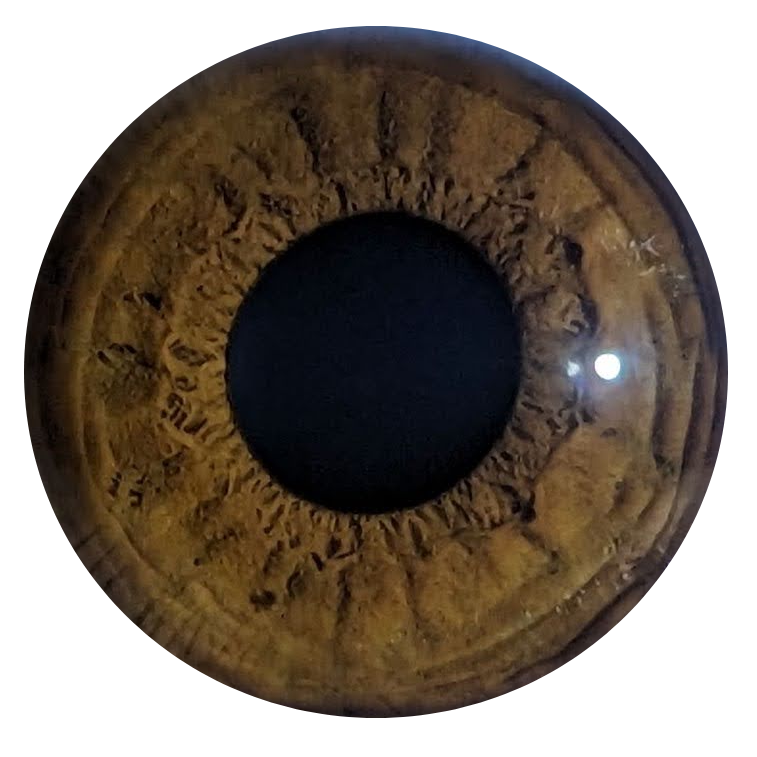
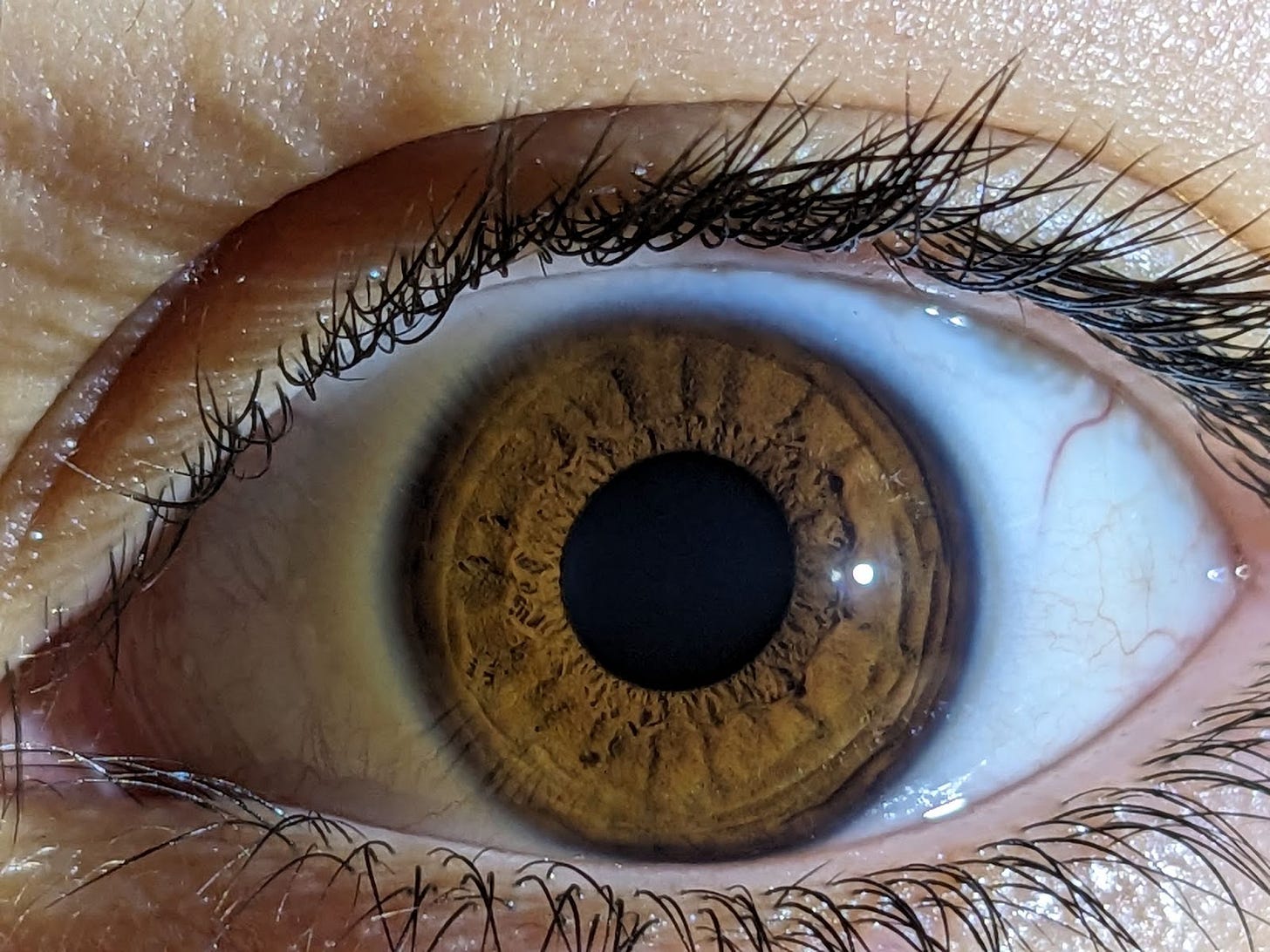
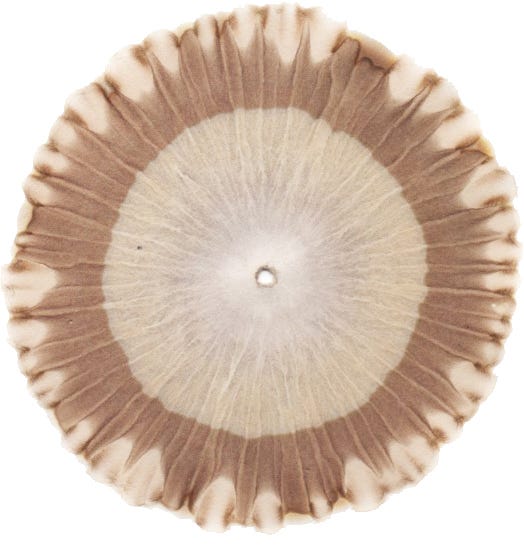
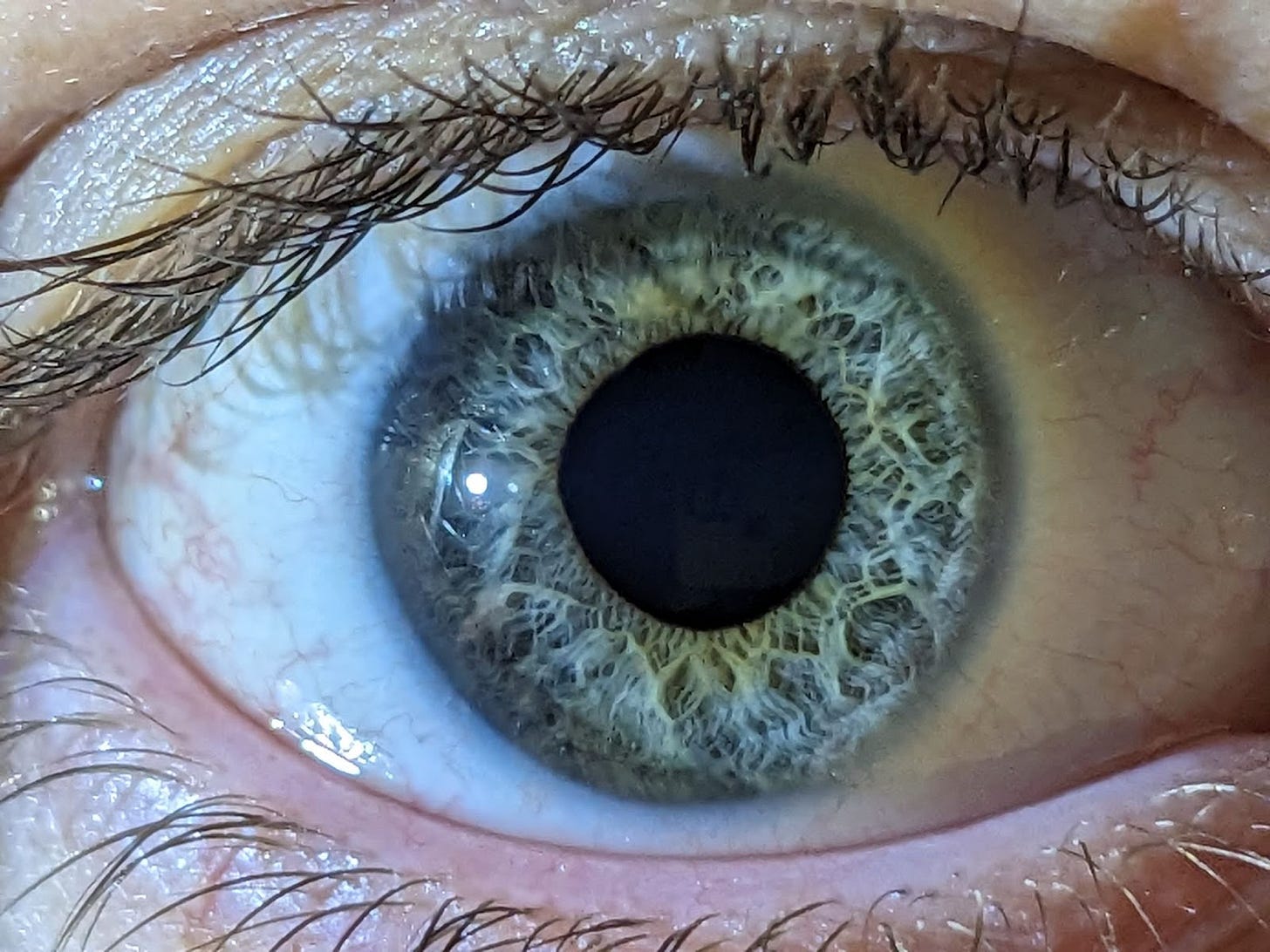


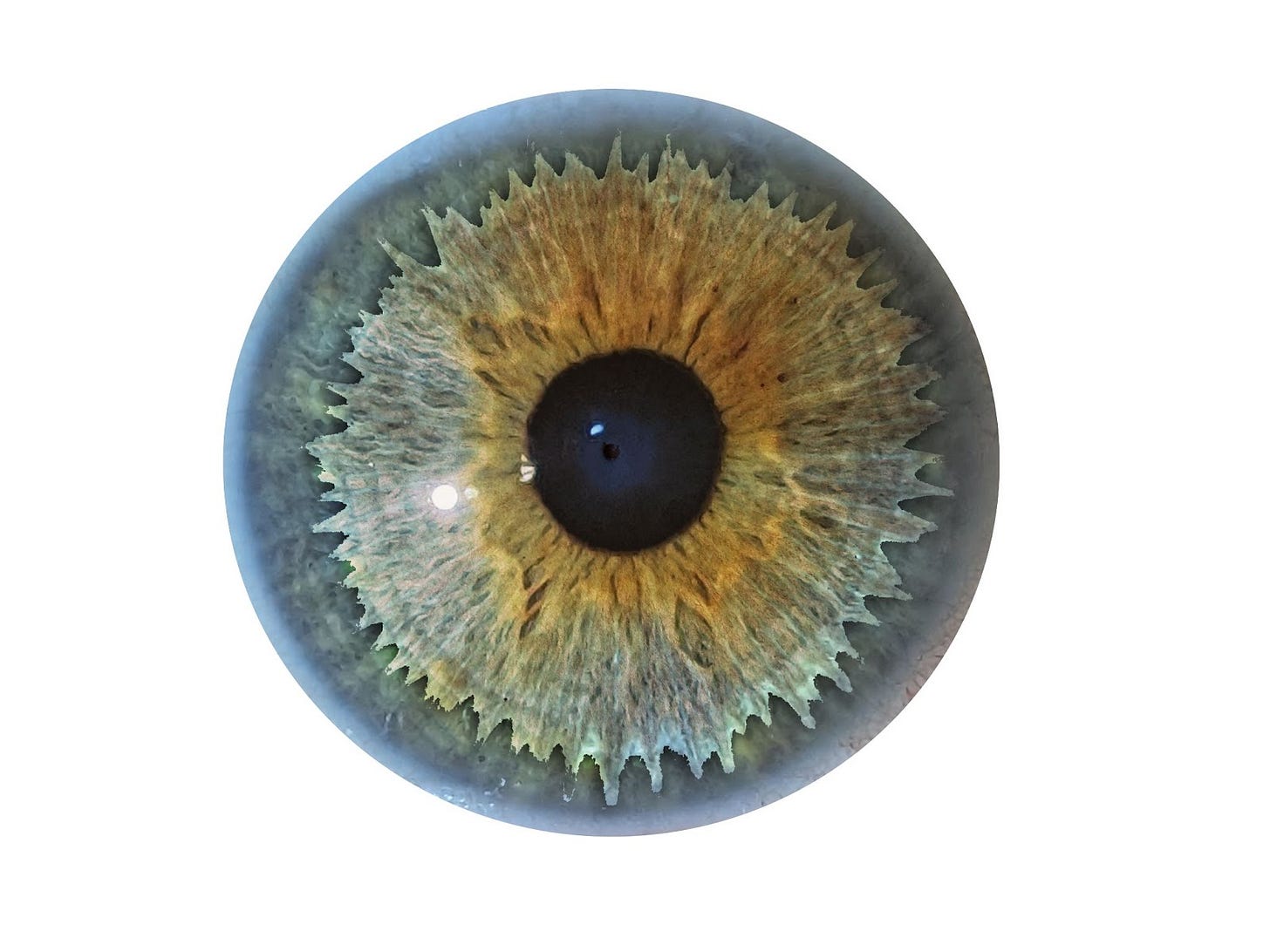



These are really ingenious, amazing, thoughtful, future-forward ideas put together so creatively and consciously. I can't wait to see what your discoveries/revelations are!
Thanks for the support!!